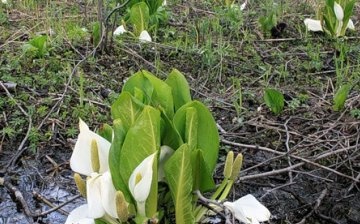Marsh calla - poisonous, but beautiful
Marsh calla occurs in nature quite often. This plant belongs to perennials, prefers damp, humid places for habitation.
If you see a calla for the first time, then you can take it for a calla - its flowers are so similar to it. And this is not strange: calla lilies and spathiphyllum, familiar to many lovers of indoor plants, are his close relatives.
Calla is called marsh calla due to its resemblance to calla lilies. It grows in swamps, in coastal silted thickets, and is able to cover large areas.
This plant does not bloom for long: from May to June. But the marsh calla looks no less decorative at the time of the formation and ripening of fruits on it: they look like red berries.
The plant propagates most often by transferring seeds by water birds eating berries, or with the flow of water. Calla can also be propagated by dividing rhizomes, but this method is less successful than seed propagation.
It is worth noting the fact that all parts of this marsh beauty are poisonous! Poisoning is manifested by a slowing of the heartbeat, convulsions, vomiting, and in high doses, a fatal outcome is likely. Therefore, be careful when handling calla.
The marsh calla is suitable for those who want to quickly decorate an artificial pond at their summer cottage: it grows quickly, is frost-hardy, and is unpretentious in care.
When planting calla, it is necessary to find a place in partial shade, its embedding depth should be no more than 15 cm. The rhizome of the plant when planting is placed in a container necessary to limit the space for growth, otherwise the pond can quickly overgrow and turn into a swamp.



